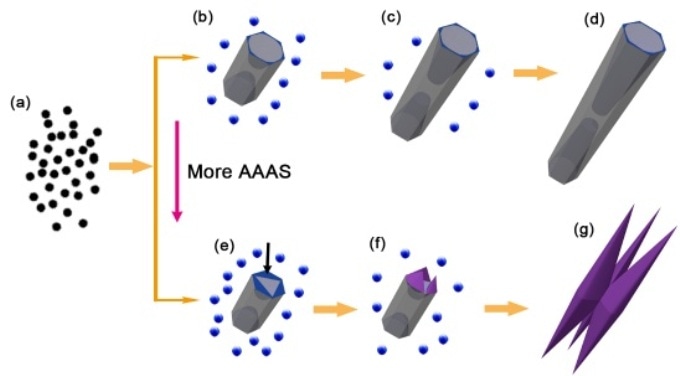Jun 30 2017
Over the past two decades, one dimensional nanomaterials such as nanotubes (NTs), nanobelts, nanowires (NWs) and nanorods (NRs) have become increasingly popular because of their shape dependent physical and chemical properties.
 Figure: Schematic growth route of the Te NTs and trifold Te NRs. (a) amorphous Te in initial stage; (b) initial seed of the Te NTs; (c) middle product of the Te NTs; (d) final crystal of the Te NTs; (e) initial seed of the trifold Te NRs; (f) middle product of the trifold Te NRs; (g) final crystal of the trifold Te NRs. (Image by ZHONG Binnian)
Figure: Schematic growth route of the Te NTs and trifold Te NRs. (a) amorphous Te in initial stage; (b) initial seed of the Te NTs; (c) middle product of the Te NTs; (d) final crystal of the Te NTs; (e) initial seed of the trifold Te NRs; (f) middle product of the trifold Te NRs; (g) final crystal of the trifold Te NRs. (Image by ZHONG Binnian)
Tellurium (Te) refers to a narrow direct band gap semiconducting material with band gap of ~0.35 eV at room temperature. Crystalline Te exhibits physical properties including thermoelectric and photoconductivity properties. Significant efforts have been carried out to synthesize the Te nanostructures. Solution-based approaches such as solvothermal or hydrothermal method are considered to be a cost-effective and large-scale preparation method for nanomaterials.
The essential factors for the development of Te nanomaterials are not clear, and hence it is extremely important to search for optimal conditions, understand the growth mechanism for designing the fabricating routes and fabricate ultra-uniform nanostructures.
A Chinese research team headed by Prof. FEI Guangtao from Institute of Solid State Physics, Hefei Institutes of Physical Science of Chinese Academy of Sciences reported a simple route for realizing controllable synthesis of Te nanostructures in large quantity by a solvothermal process. The study features in CrystEngComm.
Poly (vinyl pyrrolidone) (PVP) is used as a surfactant and ascorbic acid aqueous solution (AAAS) serves as reducing agent in this study. Researchers developed ultra-thin Te NWs, NTs and trifold NRs by altering the amounts of the surfactant and reducing agent. The diameter of the NTs and Te NWs is 120–150 nm and 30–40 nm, respectively.
A morphology evolution diagram based on varied amounts of AAAS and PVP was presented by the Researchers, who also meticulously investigated the effects of temperature.
This was followed by a discussion on the growth mechanism of the trifold Te NRs and Te NTs based on the crystallization law.
This study demonstrated the morphology evolution of the Te nanostructures developed at 120oC, 150oC and 180oC, respectively, and also the growth route of the trifold Te NRs and Te NTs and the schematic diagram of the crystal structure of Te.
This work received support from the National Basic Research Program of China (973 Program), the National Natural Science Foundation of China, the CAS/SAFEA International Partnership Program for Creative Research Teams, and the Foundation of Director of Institute of Solid State Physics, the Chinese Academy of Sciences.